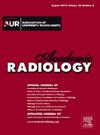基于DCE-MRI放射组学预测局部晚期直肠癌缺氧诱导因子1α表达的提名图的开发与验证
IF 3.8
2区 医学
Q1 RADIOLOGY, NUCLEAR MEDICINE & MEDICAL IMAGING
引用次数: 0
摘要
理论依据和目标:低氧诱导因子 1α(HIF-1α)的表达水平已被确定为一个关键标志物,与局部晚期直肠癌(LARC)患者的治疗反应相关。本研究旨在根据动态对比增强核磁共振成像(DCE-MRI)放射组学和临床特征,开发并验证一种用于预测局部晚期直肠癌患者HIF-1α表达的提名图:将102例确诊为局部晚期直肠癌的患者分为训练组(71例)和验证组(31例)。对 HIF-1α 的表达状态进行组织病理学分类,将患者分为高表达组和低表达组。采用类内相关系数(ICC)、最小冗余度最大相关性(mRMR)和最小绝对缩小和选择算子(LASSO)进行特征选择,构建放射组学特征并计算放射组学得分(Rad-score)。对临床特征和Rad-score进行单变量和多变量分析,构建临床模型和提名图。利用接收者操作特征曲线(ROC)、决策曲线分析(DCA)和校准曲线评估了包含临床特征和Rad-score的提名图的预测性能:结果:来自DCE-MRI的七个放射组学特征被用于构建放射组学特征。在训练队列和验证队列中,包含 CEA、Ki-67 和 Rad-score 的提名图的 AUC 值最高(AUC:0.918 和 0.920)。决策曲线分析表明,就临床实用性而言,提名图优于临床模型和放射组学特征。此外,提名图的校准曲线显示预测结果与实际观察结果之间具有良好的一致性:基于DCE-MRI放射组学和临床特征的提名图显示出良好的预测效果,可用于术前鉴别HIF-1α的表达。本文章由计算机程序翻译,如有差异,请以英文原文为准。
Development and Validation of a Nomogram Based on DCE-MRI Radiomics for Predicting Hypoxia-Inducible Factor 1α Expression in Locally Advanced Rectal Cancer
Rationale and Objectives
The expression levels of hypoxia-inducible factor 1 alpha (HIF-1α) have been identified as a pivotal marker, correlating with treatment response in patients with locally advanced rectal cancer (LARC). This study aimed to develop and validate a nomogram based on dynamic contrast-enhanced MRI (DCE-MRI) radiomics and clinical features for predicting the expression of HIF-1α in patients with LARC.
Materials and Methods
A total of 102 patients diagnosed with locally advanced rectal cancer were divided into training (n = 71) and validation (n = 31) cohorts. The expression statuses of HIF-1α were histopathologically classified, categorizing patients into high and low expression groups. The intraclass correlation coefficient (ICC), minimum redundancy maximum relevance (mRMR), and the least absolute shrinkage and selection operator (LASSO) were employed for feature selection to construct a radiomics signature and calculate the radiomics score (Rad-score). Univariate and multivariate analyses of clinical features and Rad-score were applied, and the clinical model and the nomogram were constructed. The predictive performance of the nomogram incorporating clinical features and Rad-score was assessed using Receiver Operating Characteristics (ROC) curves, decision curve analysis (DCA), and calibration curves.
Results
Seven radiomics features from DCE-MRI were used to build the radiomics signature. The nomogram incorporating CEA, Ki-67 and Rad-score had the highest AUC values in the training cohort and in the validation cohort (AUC: 0.918 and 0.920). Decision curve analysis showed that the nomogram outperformed the clinical model and radiomics signature in terms of clinical utility. In addition, the calibration curve for the nomogram demonstrated good agreement between prediction and actual observation.
Conclusion
The nomogram based on DCE-MRI radiomics and clinical features showed favorable predictive efficacy and might be useful for preoperatively discriminating the expression of HIF-1α.
求助全文
通过发布文献求助,成功后即可免费获取论文全文。
去求助
来源期刊

Academic Radiology
医学-核医学
CiteScore
7.60
自引率
10.40%
发文量
432
审稿时长
18 days
期刊介绍:
Academic Radiology publishes original reports of clinical and laboratory investigations in diagnostic imaging, the diagnostic use of radioactive isotopes, computed tomography, positron emission tomography, magnetic resonance imaging, ultrasound, digital subtraction angiography, image-guided interventions and related techniques. It also includes brief technical reports describing original observations, techniques, and instrumental developments; state-of-the-art reports on clinical issues, new technology and other topics of current medical importance; meta-analyses; scientific studies and opinions on radiologic education; and letters to the Editor.
 求助内容:
求助内容: 应助结果提醒方式:
应助结果提醒方式:


